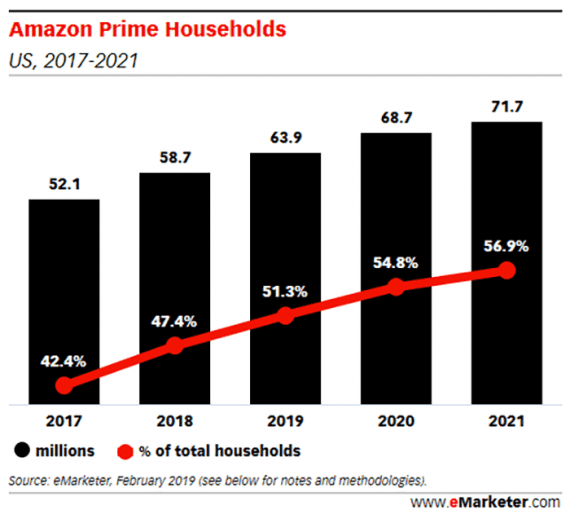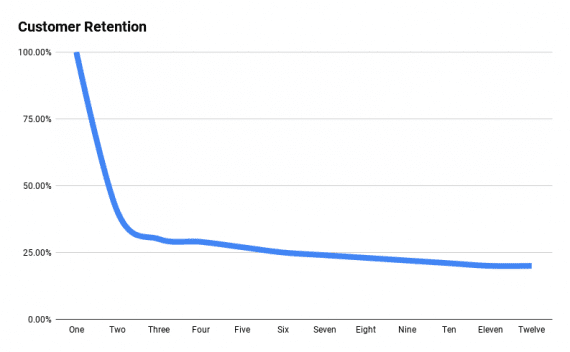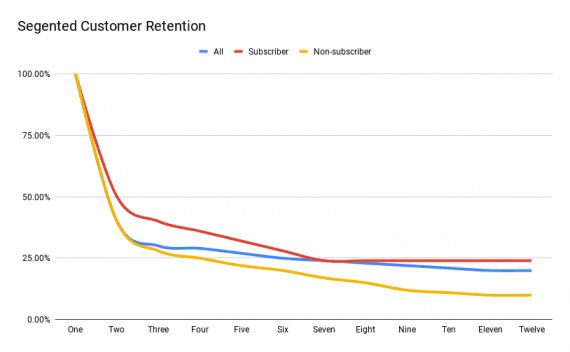Customer retention is a good indicator of an ecommerce business’s potential for long-term growth and success. With this in mind, ecommerce owners and managers should consider making customer retention a top key performance indicator.
Amazon is the clear leader in online sales. The company has created a popular platform to sell its own inventory, and it has created a massive online marketplace where thousands of merchants sell products, too. This says nothing of Amazon Web Services, Fulfillment by Amazon, and other profit centers.
Many factors contribute to Amazon’s success. One of these is customer retention. Consider some data from Amazon’s Prime membership.
There are approximately 325 million Americans in 127 million households, according to 2018 data from the U.S. Census Bureau. eMarketer has estimated 51.3 percent of American households will be Amazon Prime subscribers in 2019. Assuming every American household has tried it, Amazon Prime’s retention is 51.3 percent.

Amazon Prime has an excellent customer retention rate, and it is growing.
But not every American household has tried Prime. So the Prime retention rate is higher. But, still, I’ll use 50 percent for the examples below.
Customer Retention for Growth
What would happen to an ecommerce business, even a start-up business, if, like Prime, it could retain half of its customers?
Imagine you have a new ecommerce business. You can obtain 100 new customers each month with pay-per-click advertising. If the business retains half of those new customers for at least six months, the store would have 350 paying customers in its sixth month.
| Month | Retained Customers | New Customers | Total Customers |
|---|---|---|---|
| One | 0 | 100 | 100 |
| Two | 50 | 100 | 150 |
| Three | 100 | 100 | 200 |
| Four | 150 | 100 | 250 |
| Five | 200 | 100 | 300 |
| Six | 250 | 100 | 350 |
If the average order value for this hypothetical company were $50, the business would generate $17,500 in sales in its sixth month.
Let’s assume this store’s cost of goods sold and other expenses — shipping, overhead, marketing, labor — amount to about 75 percent of revenue. We will also assume it costs about $5 to attract a new customer, but just 50 cents to retain one.
| Month | Customers | Average Order | Total Gross Sales | Expenses | Acquisition Cost | Retention Cost | Profit |
|---|---|---|---|---|---|---|---|
| One | 100 | $50 | $5,000 | $3,750 | $500 | 0 | $750 |
| Two | 150 | $50 | $7,500 | $5,625 | $500 | $25 | $1,350 |
| Three | 200 | $50 | $10,000 | $7,500 | $500 | $50 | $1,950 |
| Four | 250 | $50 | $12,500 | $9,375 | $500 | $75 | $2,550 |
| Five | 300 | $50 | $15,000 | $11,250 | $500 | $100 | $3,150 |
| Six | 350 | $50 | $17,500 | $13,100 | $500 | $125 | $3,750 |
If the company relied on new shoppers alone, it would earn about $750 in profit for every 100 customer orders. That works out to an average profit per customer order of $7.50.
If the company retained 50 percent of customers for at least six months, its average profit per customer order in month six would be $10.71. That is a 42.8-percent increase in profit per customer order in just six months.
If we extended the time frame and the company retained half of its customers for a year, the average profit per order would be $11.31. Total profit for the 12th month would reach $7,350 on sales of $32,500. And remember, without any customer retention, the business would still be making just $750 in profit each month unless it invested significantly more in new customer acquisition.
| Month | Customers | Average Order | Total Gross Sales | Expenses | Acquisition Cost | Retention Cost | Profit |
|---|---|---|---|---|---|---|---|
| One | 100 | $50 | $5,000 | $3,750 | $500 | 0 | $750 |
| Two | 150 | $50 | $7,500 | $5,625 | $500 | $25 | $1,350 |
| Three | 200 | $50 | $10,000 | $7,500 | $500 | $50 | $1,950 |
| Four | 250 | $50 | $12,500 | $9,375 | $500 | $75 | $2,550 |
| Five | 300 | $50 | $15,000 | $11,250 | $500 | $100 | $3,150 |
| Six | 350 | $50 | $17,500 | $13,100 | $500 | $125 | $3,750 |
| Seven | 400 | $50 | $20,000 | $15,000 | $500 | $150 | $4,350 |
| Eight | 450 | $50 | $22,500 | $16,875 | $500 | $175 | $4,950 |
| Nine | 500 | $50 | $25,000 | $18,750 | $500 | $200 | $5,550 |
| Ten | 550 | $50 | $27,500 | $20,625 | $500 | $225 | $6,150 |
| Eleven | 600 | $50 | $30,000 | $22,500 | $500 | $250 | $6,750 |
| Twelve | 650 | $50 | $32,500 | $24,375 | $500 | $275 | $7,350 |
Measuring Customer Retention
There are a few ways an ecommerce company could measure and thereby focus on improving customer retention. But one of the easiest methods to understand and execute may be so-called bracketed retention.
If, as an example, the goal was to encourage shoppers to purchase at least once each month, the company could create a “bracket” for months one through 12.
| Month | Retention |
|---|---|
| One | 100.00% |
| Two | 40.00% |
| Three | 30.00% |
| Four | 29.00% |
| Five | 27.00% |
| Six | 25.00% |
| Seven | 24.00% |
| Eight | 23.00% |
| Nine | 22.00% |
| Ten | 21.00% |
| Eleven | 20.00% |
| Twelve | 20.00% |
In the first month of measuring retention, 100 percent of new customers are retained. In our example, 40 percent of those same customers come back for a second month and make a purchase giving the business a 40-percent retention rate after two months.
As the company keeps collecting data for 12 months and beyond, it will see a retention curve form.

One goal could be to have the retention curve flatten out and run parallel to the x-axis.
In a successful and growing ecommerce business, the goal would be to have the curve eventually flatten out and run parallel to the horizontal axis, showing a long term customer retention rate.
Impacting Customer Retention
Once a business has started to measure retention rate month-to-month, it can begin to ask questions about how to impact shopper loyalty. This can be done by segmenting data around customer behavior or demographics.
Here is a chart showing the 12-month retention rates for an ecommerce business. There is a retention rate for all customers, and a retention rate for customers who are also email newsletter subscribers.
| Month | All | Subscriber | Non-subscriber |
|---|---|---|---|
| One | 100.00% | 100.00% | 100.00% |
| Two | 40.00% | 50.00% | 40.00% |
| Three | 30.00% | 40.00% | 28.00% |
| Four | 29.00% | 36.00% | 25.00% |
| Five | 27.00% | 32.00% | 22.00% |
| Six | 25.00% | 28.00% | 20.00% |
| Seven | 24.00% | 24.00% | 17.00% |
| Eight | 23.00% | 24.00% | 15.00% |
| Nine | 22.00% | 24.00% | 12.00% |
| Ten | 21.00% | 24.00% | 11.00% |
| Eleven | 20.00% | 24.00% | 10.00% |
| Twelve | 20.00% | 24.00% | 10.00% |
This data, again as an example, might show the business that encouraging customers to subscribe to the email newsletter will also boost retention rate.

Comparing different segments or cohorts may help a company understand how to improve customer retention.
This kind of segment is sometimes referred to as a cohort, and this sort of research is called cohort analysis. Your ecommerce business might segment customers around the month they purchase to learn if holiday shoppers are more or less likely to be loyal shoppers. Or you could compare customers by region. Are customers in some areas of the country more likely to be loyal shoppers than others?
Each question you ask about what impacts customer retention should help identify steps to improve it.